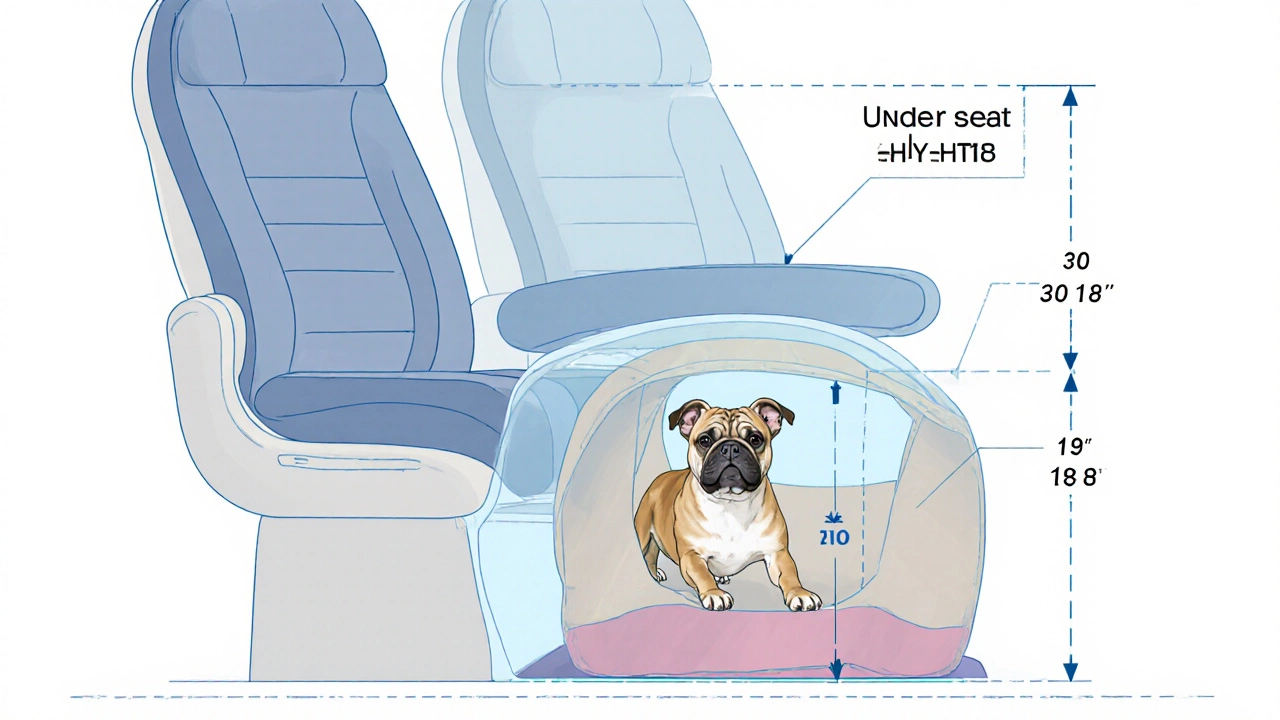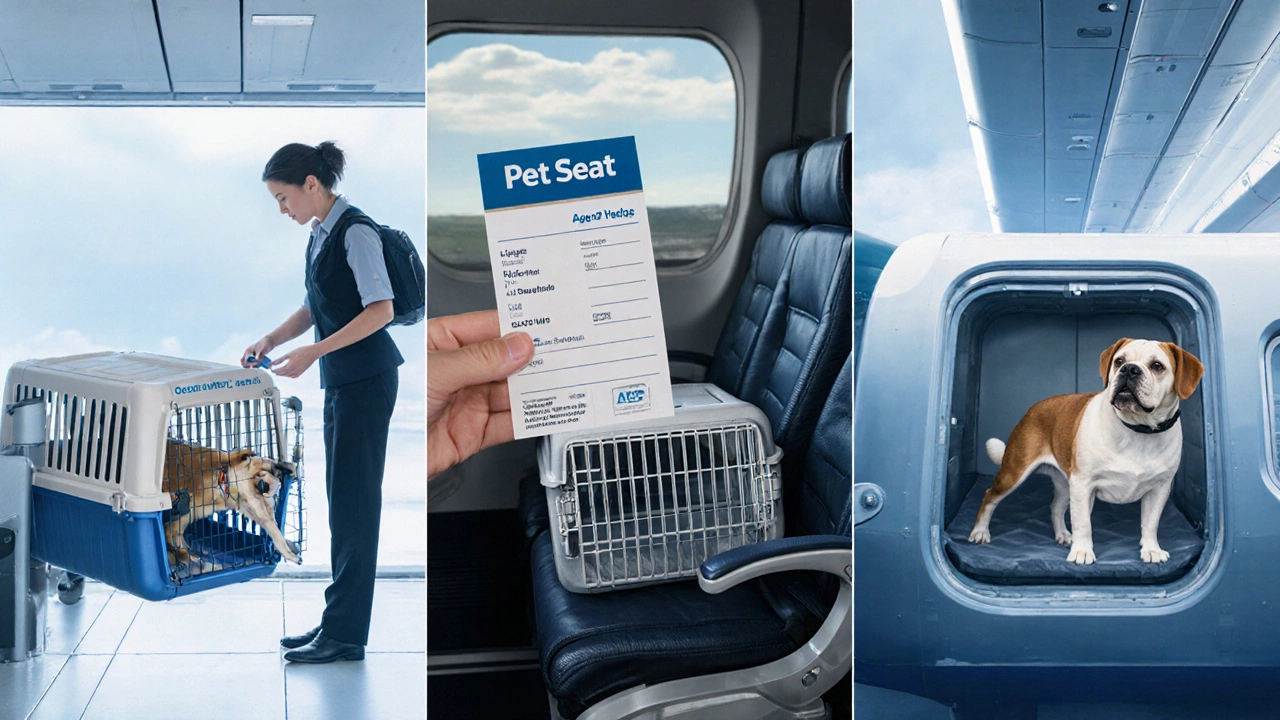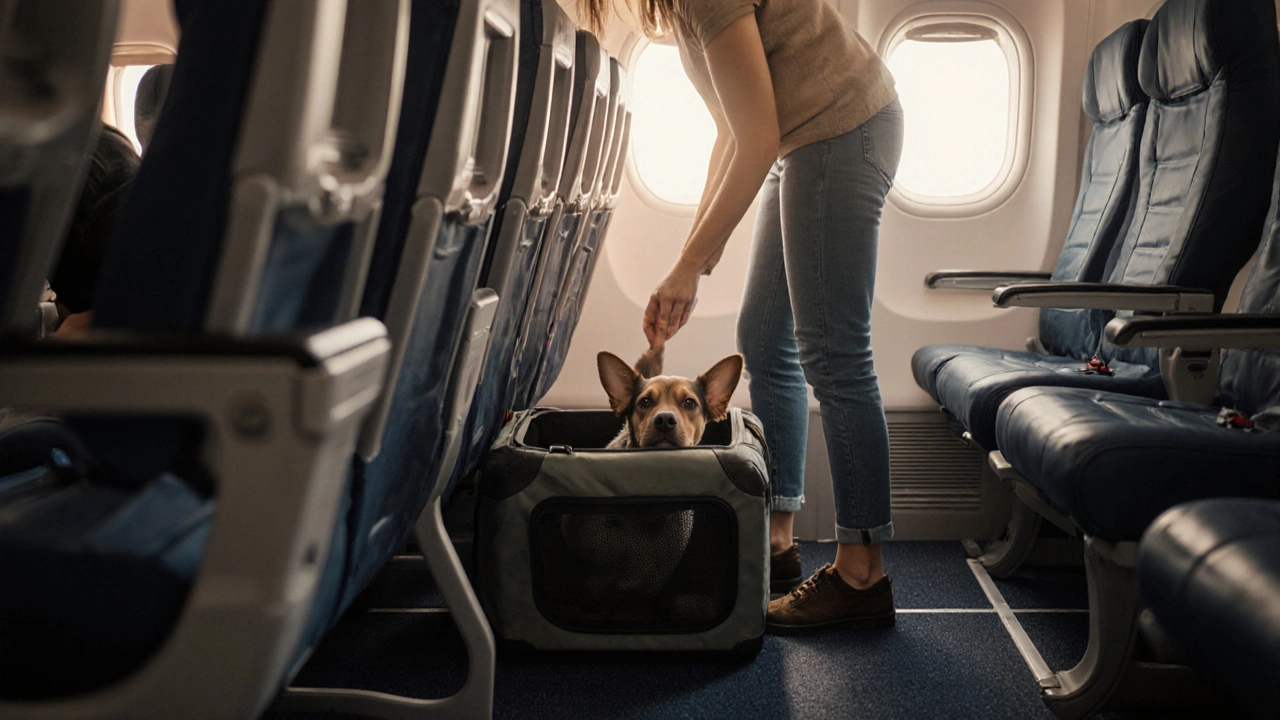30-lb Dog Airline Seat Fit Calculator
Dog Size Calculator
Enter your dog's measurements to determine if it will fit under the airline seat.
Enter your dog's measurements and select an airline to see if your dog will fit under the seat.
Wondering if your 30‑pound dog can nest under the seat on a flight? You’re not alone. Many pet owners face the same question when planning a cabin trip. The short answer is: it depends on the airline, the seat layout, and the carrier you choose. This guide walks you through the numbers, compares major carriers, and gives practical steps so you stop guessing and start packing with confidence.
Why Seat Size Matters for Pets
Airlines treat a dog in the cabin as part of your carry‑on baggage. That means the carrier must fit in the same space allotted to a personal item-usually the area beneath the row in front of you. If the carrier is too big, the flight crew will ask you to gate‑check the pet or purchase an extra seat, which adds cost and logistics.
Typical Airline Seat Dimensions
Seat dimensions vary by aircraft type and cabin class. Here are the three most relevant measurements:
- Seat width: 17-18 inches (43-46 cm) in economy, 19-20 inches (48-51 cm) in premium economy.
- Seat pitch: the distance from a point on one seat to the same point on the seat in front. Economy usually offers 30-32 inches (76-81 cm).
- Under‑seat height: roughly 18-20 inches (46-51 cm) from floor to ceiling of that space.
These numbers set the maximum carrier dimensions you can realistically bring on board.
Translating Dog Weight to Carrier Size
Weight alone doesn’t tell the whole story. A compact 30‑pound terrier will sit differently inside a crate compared to a stocky bulldog of the same weight. Most airlines require a carrier that allows the pet to stand, turn, and lie down comfortably.
Industry‑standard carrier sizing follows a length × width × height rule, typically expressed in inches. For a 30‑pound dog, the recommended carrier size falls between 19‑20 in (L) × 14‑15 in (W) × 10‑11 in (H). This fits within most under‑seat clearances, but you still need to verify airline‑specific limits.
Key Airline Policies (2025)
Below is a quick snapshot of how four major carriers handle pet travel. All figures reflect public data as of October 2025 and may change, so always double‑check before booking.
| Airline | Max Carrier Dimensions (L × W × H) | Max Pet Weight | Notes |
|---|---|---|---|
| Delta Air Lines | 18 × 11 × 11 in | Up to 30 lb | Carrier must fit under seat; front‑row seats not allowed for pets. |
| United Airlines | 17 × 12 × 10 in | Up to 30 lb | Pets not permitted in first‑class or on some international flights. |
| Air New Zealand | 19 × 12 × 11 in | Up to 35 lb | Allows pets in premium economy; carrier must be airline‑approved. |
| Qantas | 18 × 12 × 10 in | Up to 30 lb | Only domestic flights; carrier must be ventilated. |
Understanding the Role of pet carrier a portable enclosure that meets airline size and ventilation standards for cabin travel
When you buy a carrier, look for these features:
- Soft‑sided but sturdy construction-flexible enough to tuck under the seat yet supportive.
- Ventilation panels on at least three sides.
- Secure, lockable latch that the crew can open for inspection.
- Clear labeling area for your pet’s name and your contact info.
Most reputable brands list the exact exterior dimensions. Double‑check that the listed size is inside the 30 pound dog airline seat limit you noted earlier.

Steps to Verify Fit Before You Book
- Measure your dog’s length (nose to tail base) and height (shoulder to floor). Add 2-3 inches to each dimension for comfort.
- Select a carrier that matches those internal measurements and stays within the airline’s external limits.
- Measure the seat on the plane you’ll be using. Many airline websites publish seat maps; otherwise, call the reservation desk.
- Place the carrier on the floor of your home or a sturdy table and measure the clearance from the back of the seat to the floor. It should be equal to or less than the airline’s declared under‑seat height.
- Pack a travel‑size water bowl, a blanket, and a favorite toy, then do a quick “squat test” to see if your dog can comfortably sit and turn inside the carrier.
What If the Carrier Doesn’t Fit?
Don’t panic. You have a few options:
- Gate‑check the pet: Some airlines let you drop the carrier at the gate and retrieve it at baggage claim.
- Purchase a seat for the dog: This guarantees space but costs roughly 75 % of a regular adult ticket.
- Choose a different flight: Early‑morning or late‑night flights often have fewer passengers, giving you more flexible seating.
- Switch to a larger carrier and travel as cargo-a pricier route but sometimes the only safe alternative for larger breeds.
Checklist Before You Fly
- Confirm pet travel policy on the airline’s official site (look for “in‑cabin pet” section).
- Verify carrier dimensions against the airline’s limits.
- Measure your dog and compare to carrier interior size.
- Book a seat with a non‑reclining seat in front, if possible.
- Arrange a health certificate from your vet (often required within 10 days of travel).
- Label the carrier with your name, phone, and destination address.
- Pack a travel‑size pet first‑aid kit: bandages, antiseptic wipes, and any prescribed medication.
Quick Takeaways
- Most airlines allow carriers up to roughly 18 × 12 × 11 in for cabin pets.
- A 30‑pound dog typically needs a carrier around 19 × 14 × 10 in.
- Check seat width (17-18 in) and under‑seat height (≈18 in) on your specific flight.
- Use the step‑by‑step fit test at home before you book.
- If it won’t fit, consider gate‑checking, buying a pet seat, or flying as cargo.

Can I bring a 30‑pound dog on a short‑haul flight?
Yes, if the airline’s cabin pet policy permits a carrier that meets its size limits. Most short‑haul routes on major U.S. and Oceanic airlines allow carriers up to 18 × 12 × 11 in, which accommodates a 30‑pound dog in a properly sized soft‑sided carrier.
Do I need a health certificate for a 30‑pound dog?
Most airlines require a recent health certificate-usually issued within ten days of travel. Some destinations, especially international ones, also demand rabies vaccination records and a copy of the pet’s passport.
What if my carrier is a centimeter too big?
Airline staff will likely ask you to gate‑check the pet or purchase a seat. It’s best to avoid the last‑minute scramble by measuring twice and confirming the carrier’s external dimensions before you arrive at the airport.
Are soft‑sided carriers always better than hard‑sided ones?
Soft‑sided carriers are more likely to fit under the seat because they can compress slightly, but hard‑sided carriers may offer better protection on rough handling. Choose based on airline policy-some carriers specifically require soft sides for cabin travel.
How early should I arrive at the airport with my dog?
Plan to be at the check‑in desk at least two hours before domestic flights and three hours before international departures. This gives you time for paperwork, carrier inspection, and any last‑minute adjustments.
